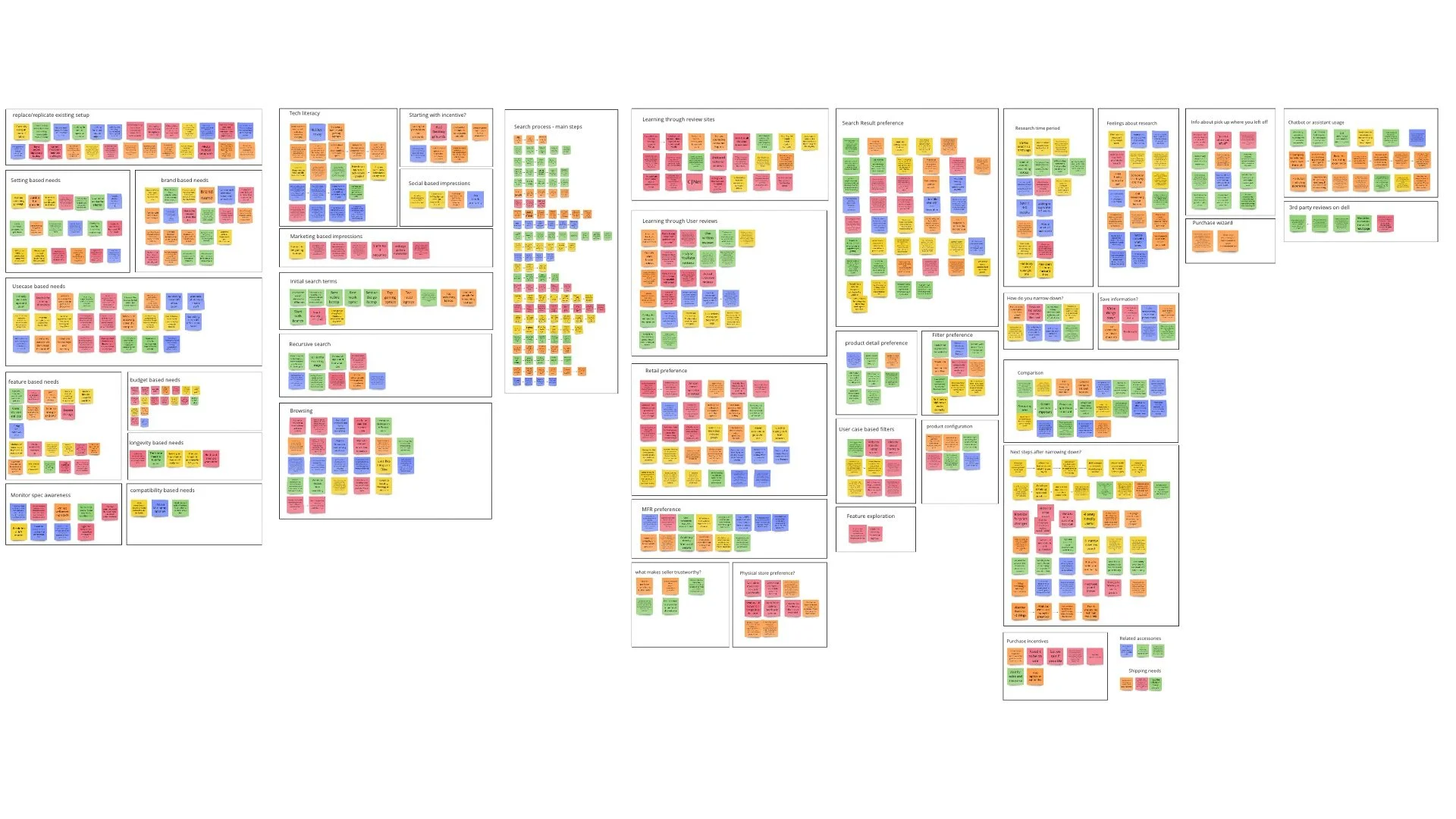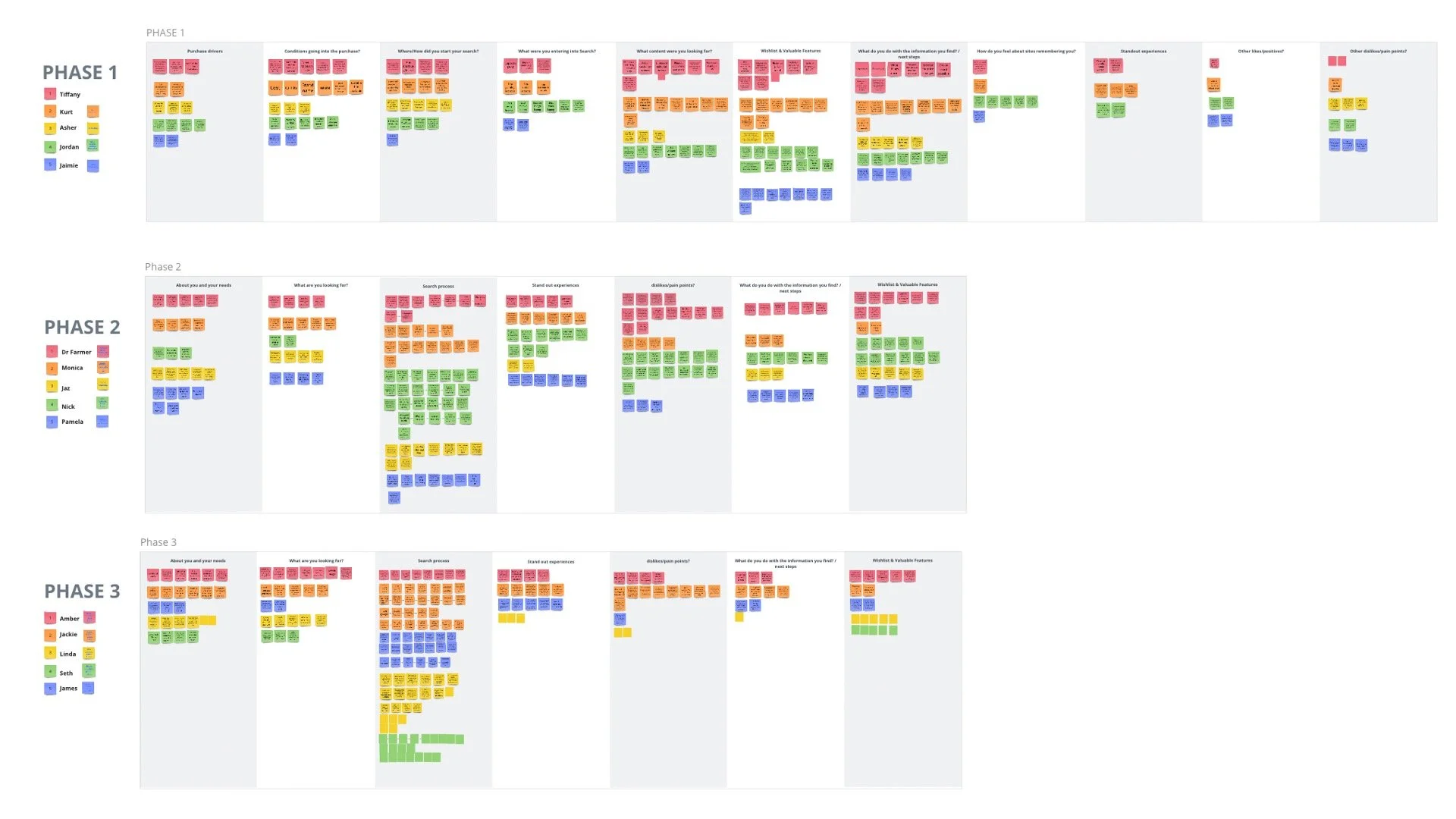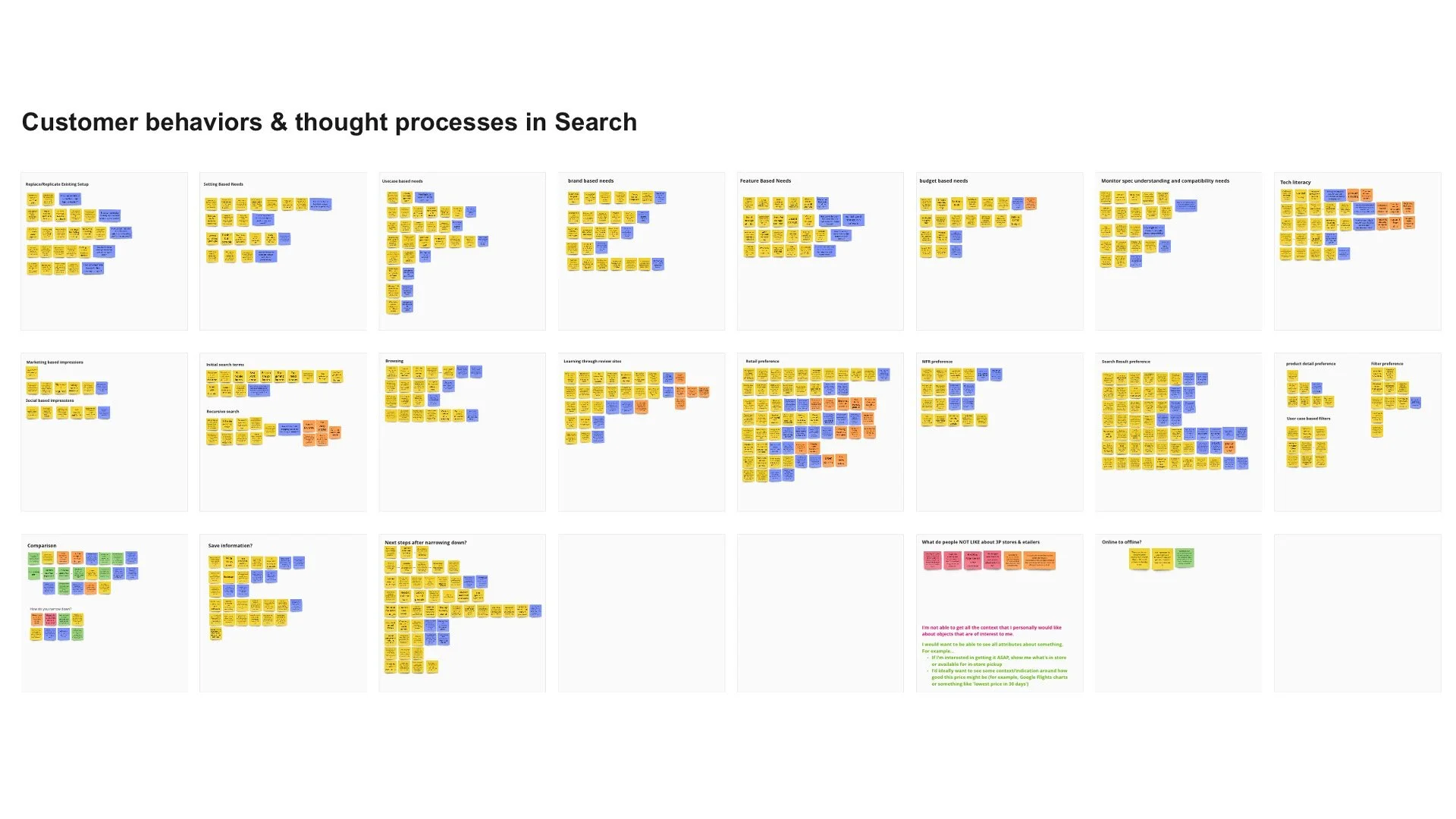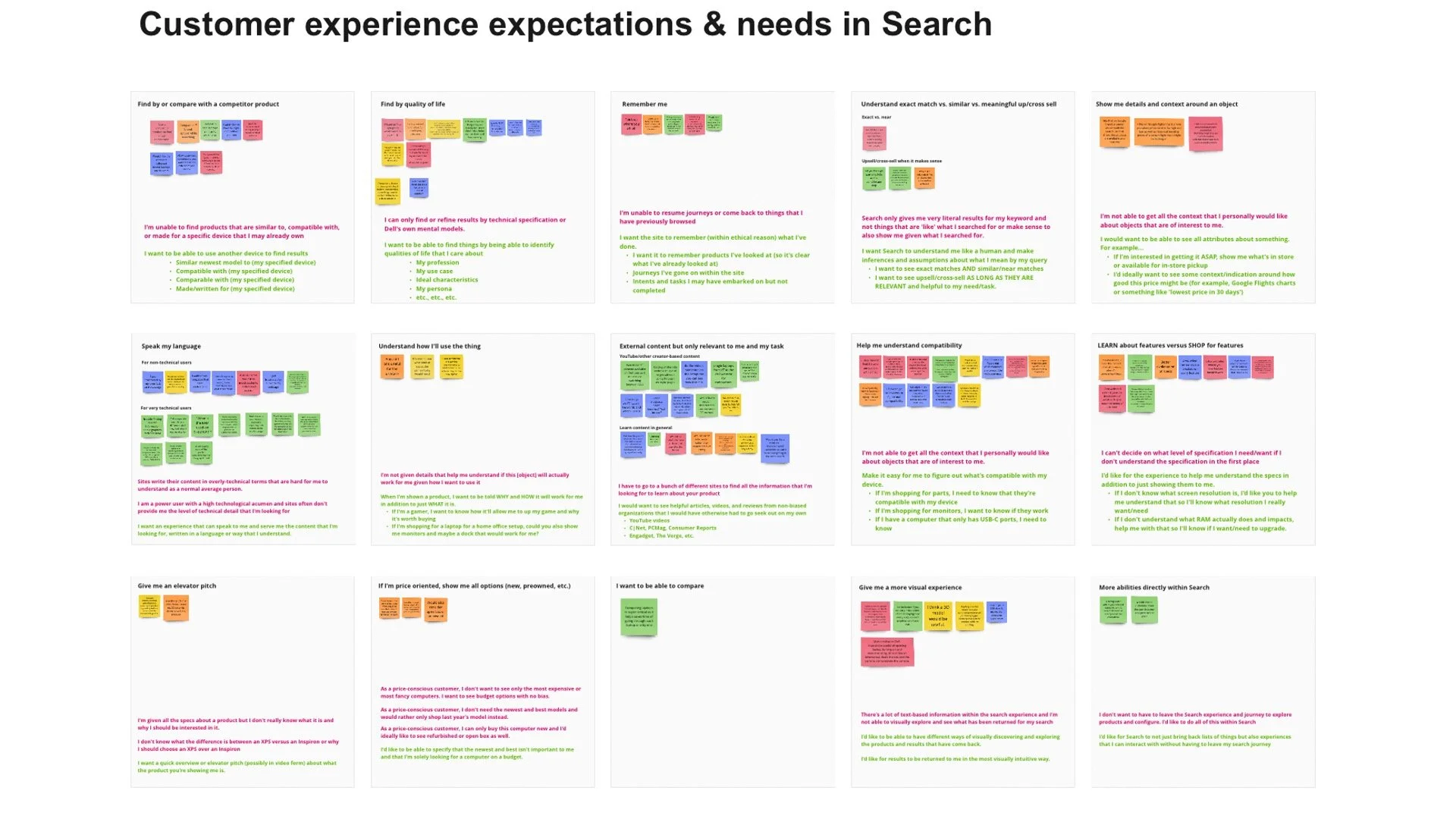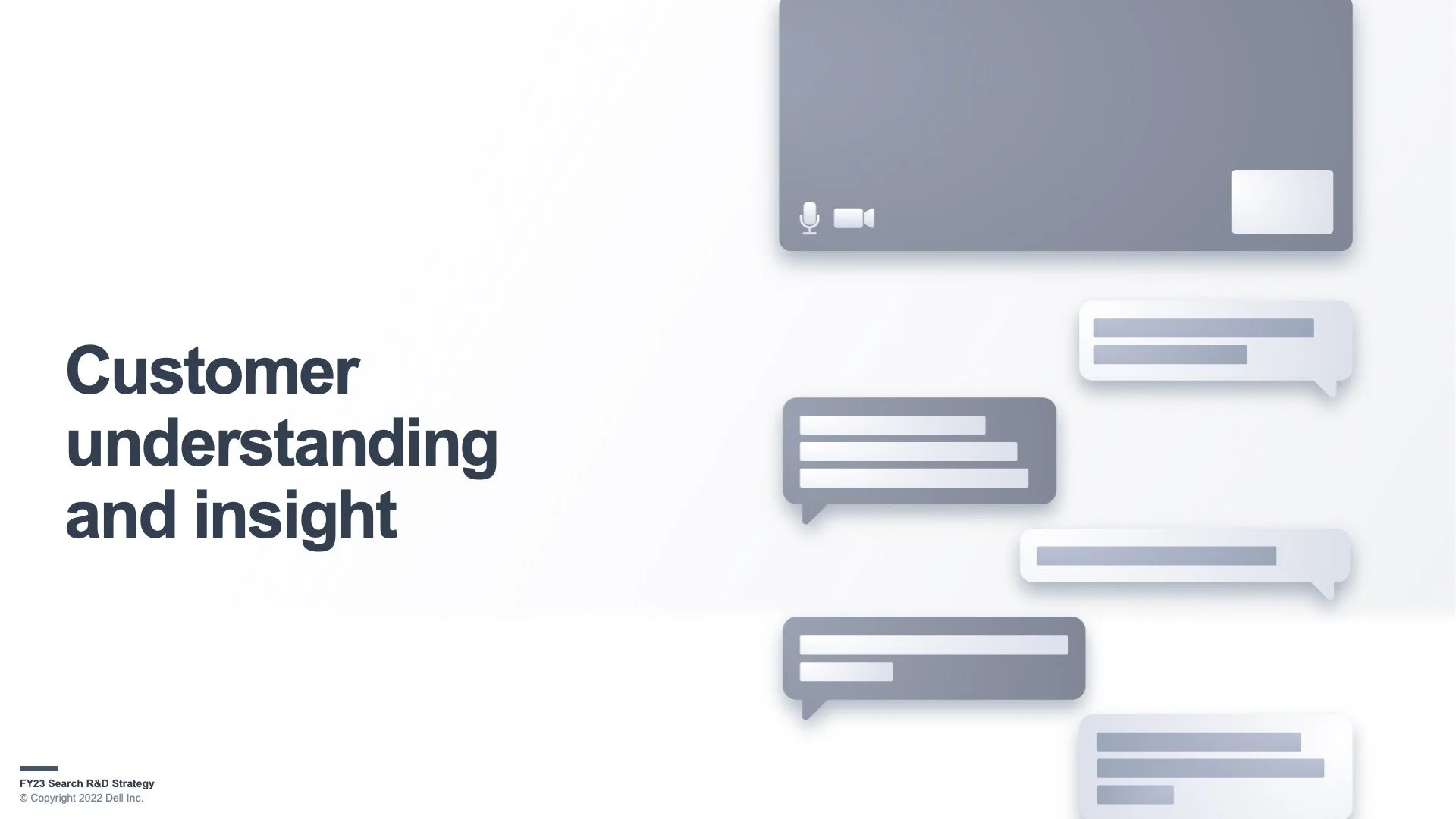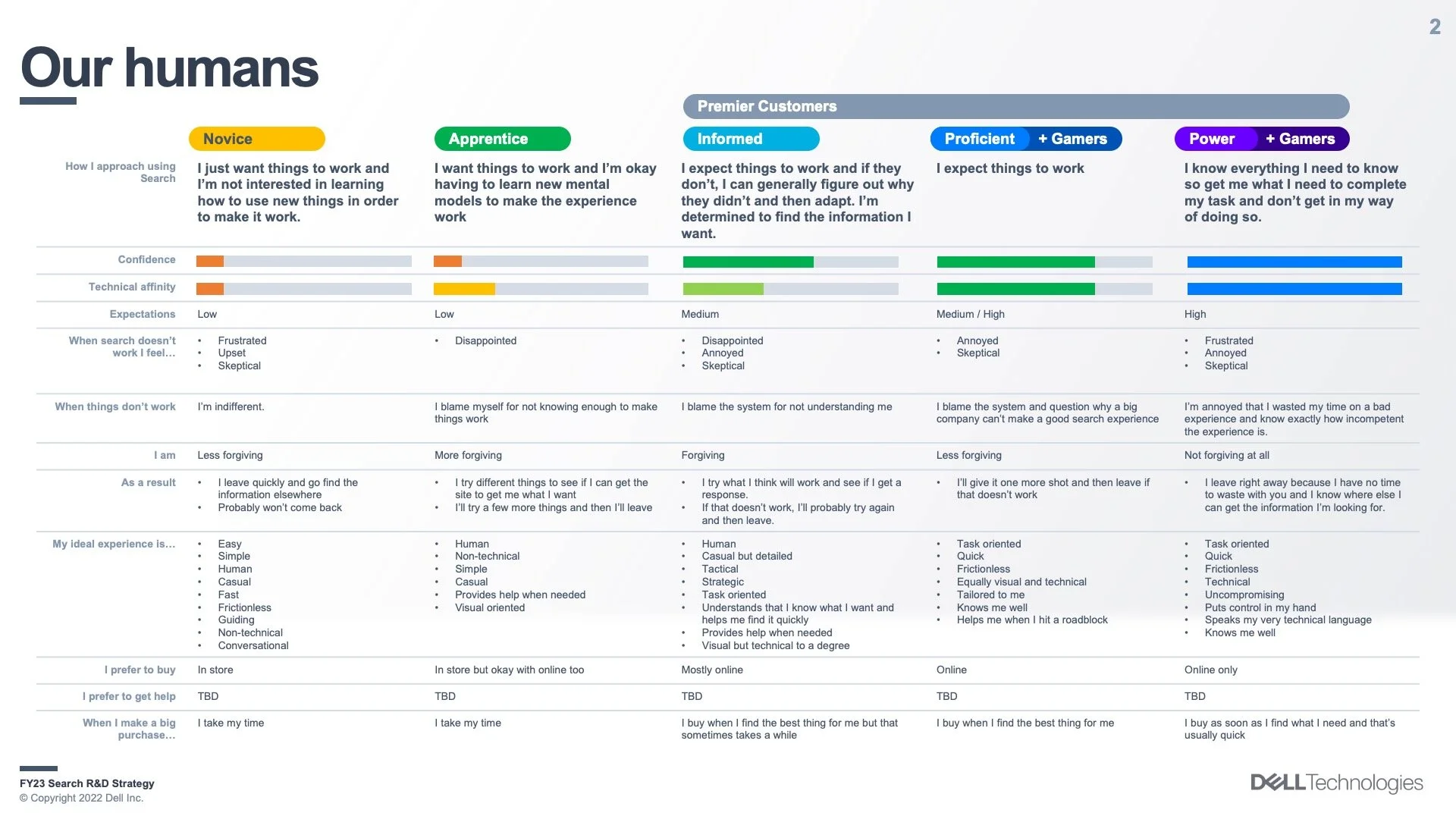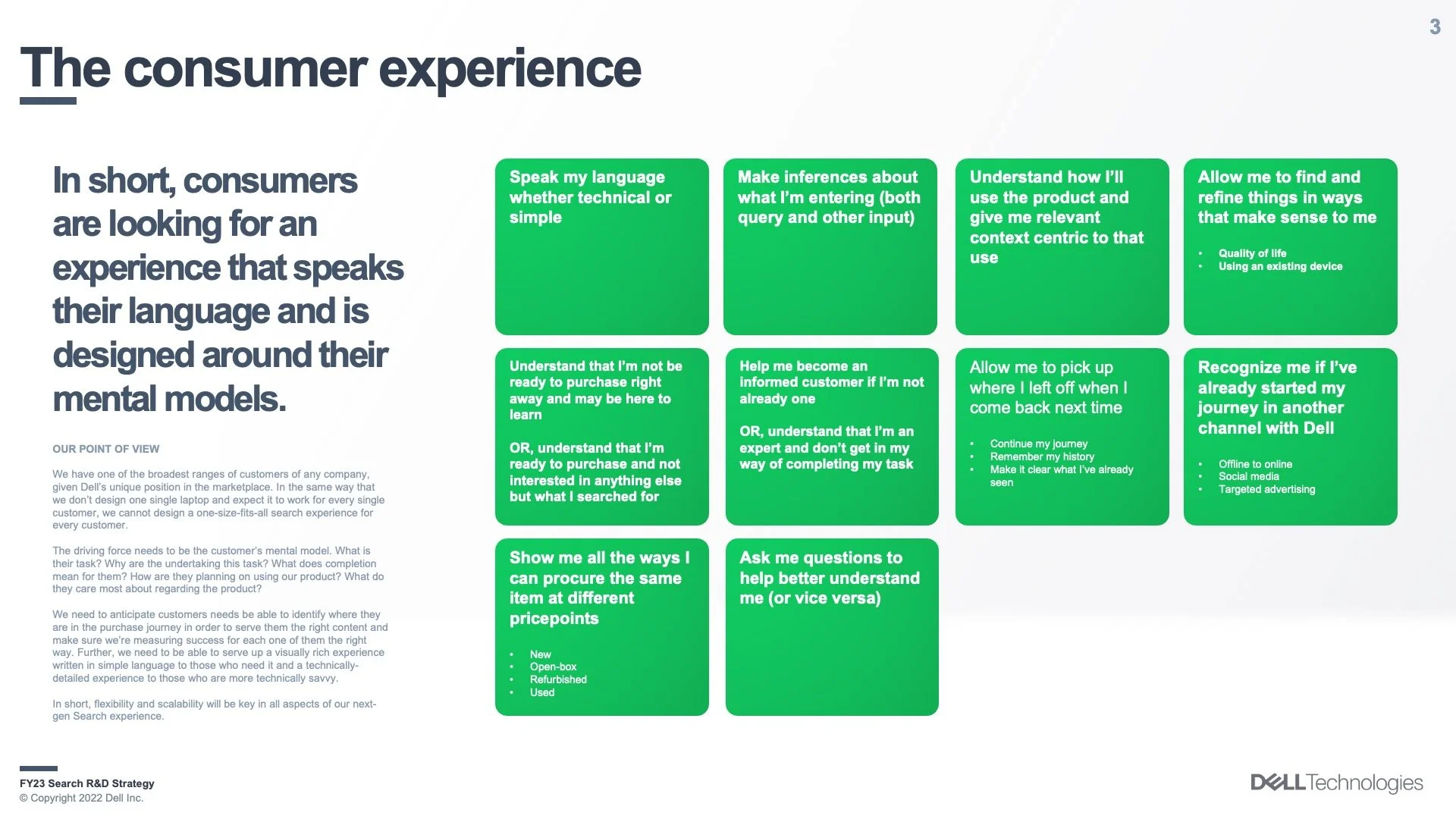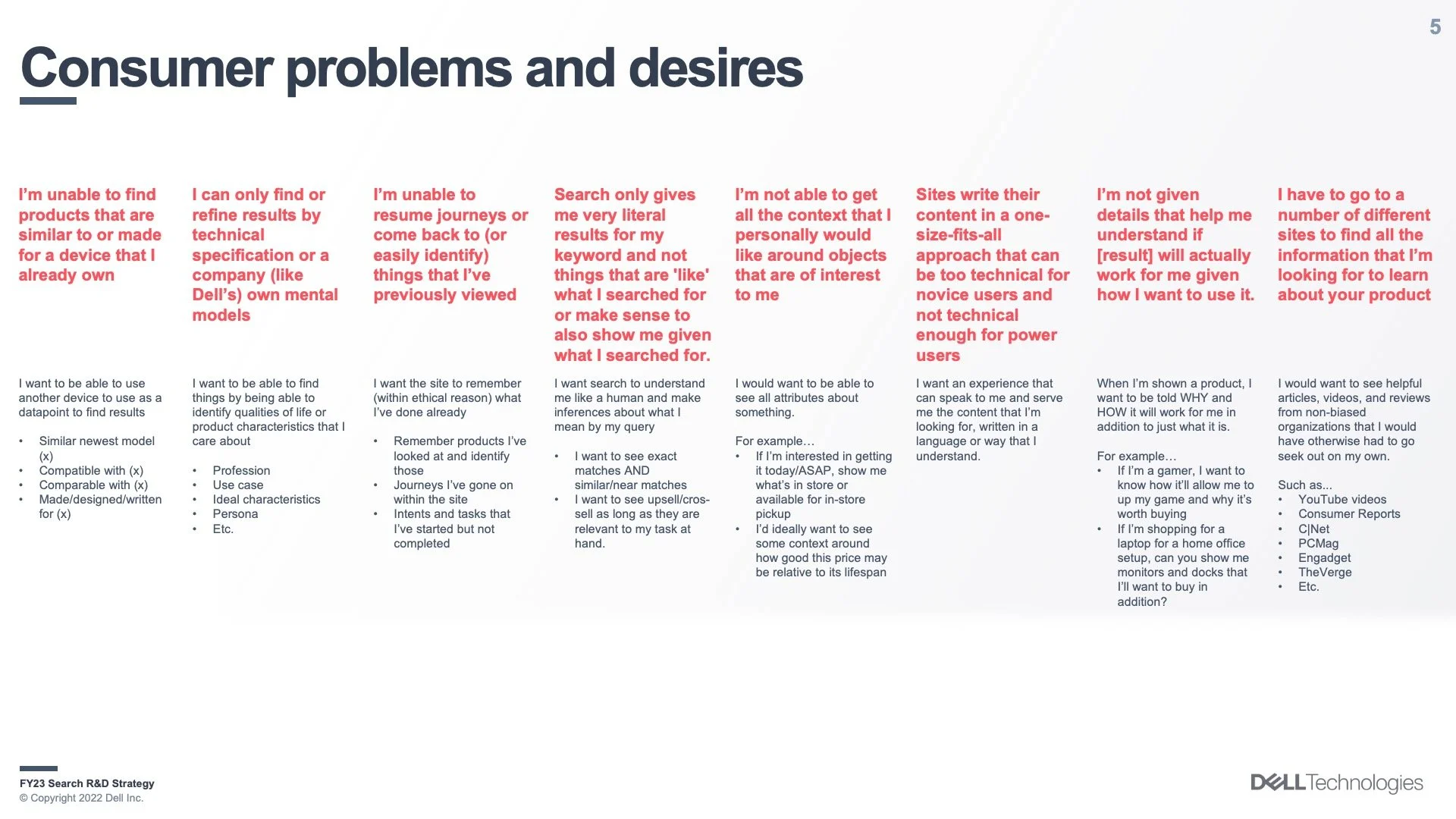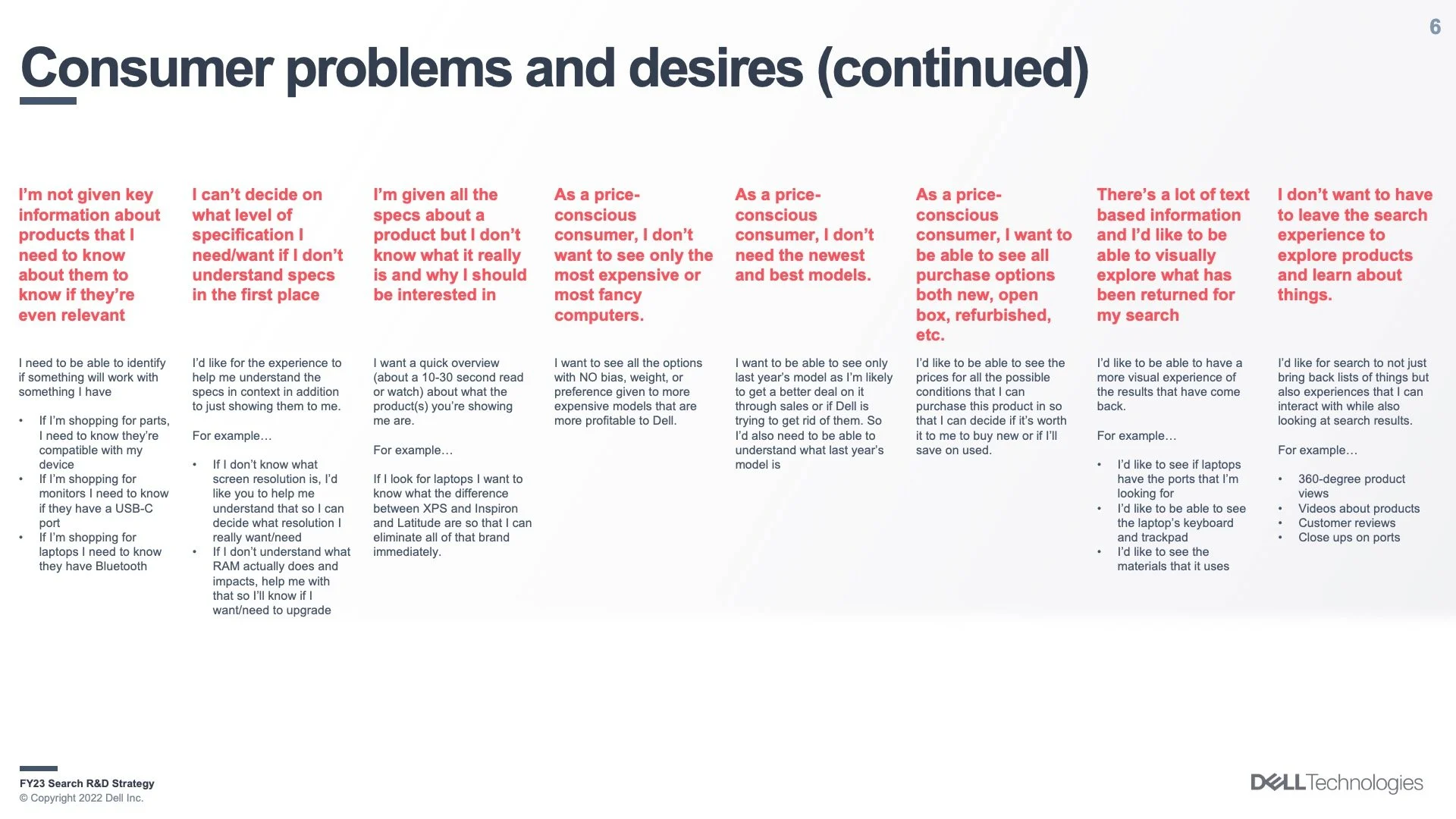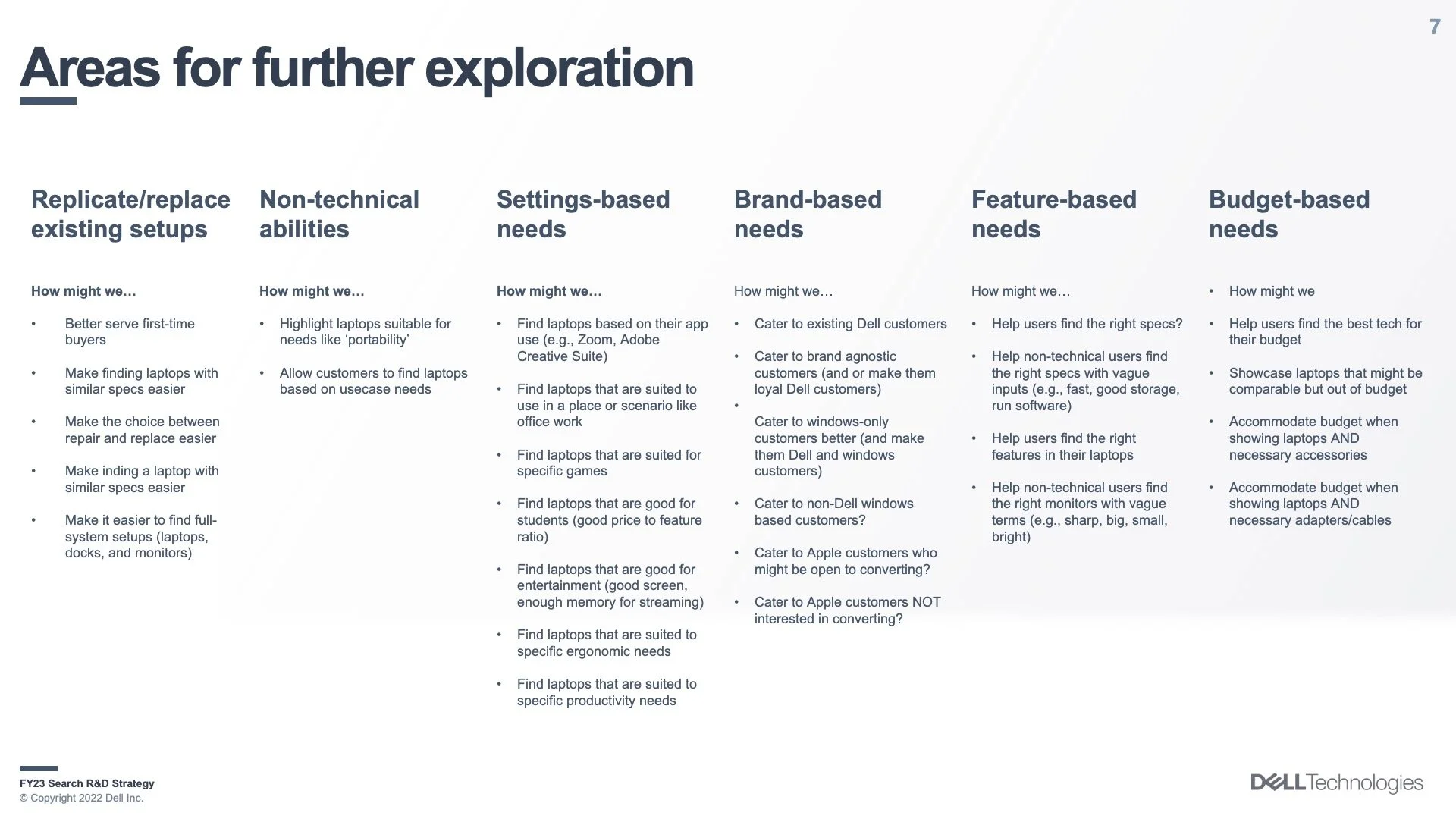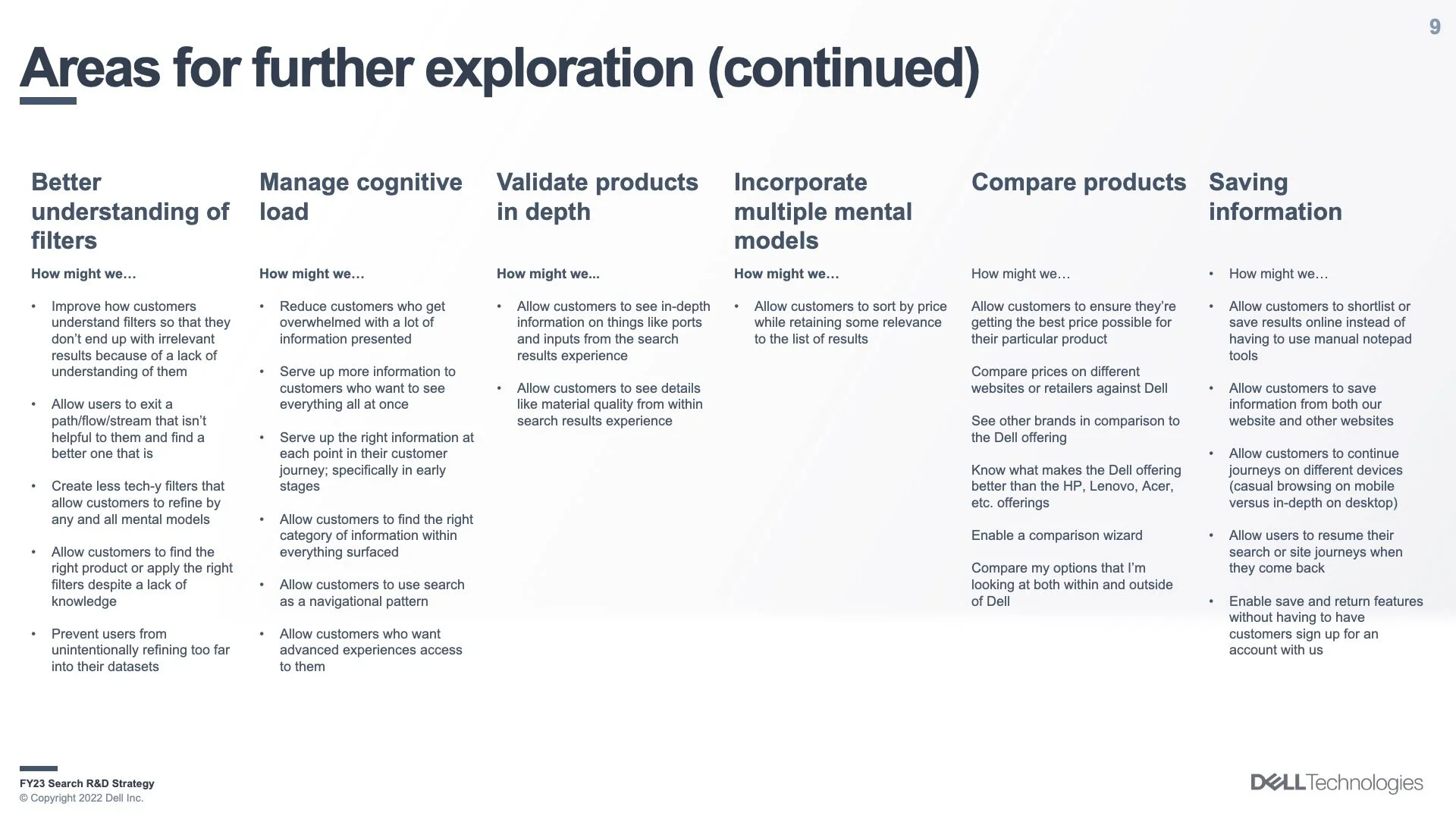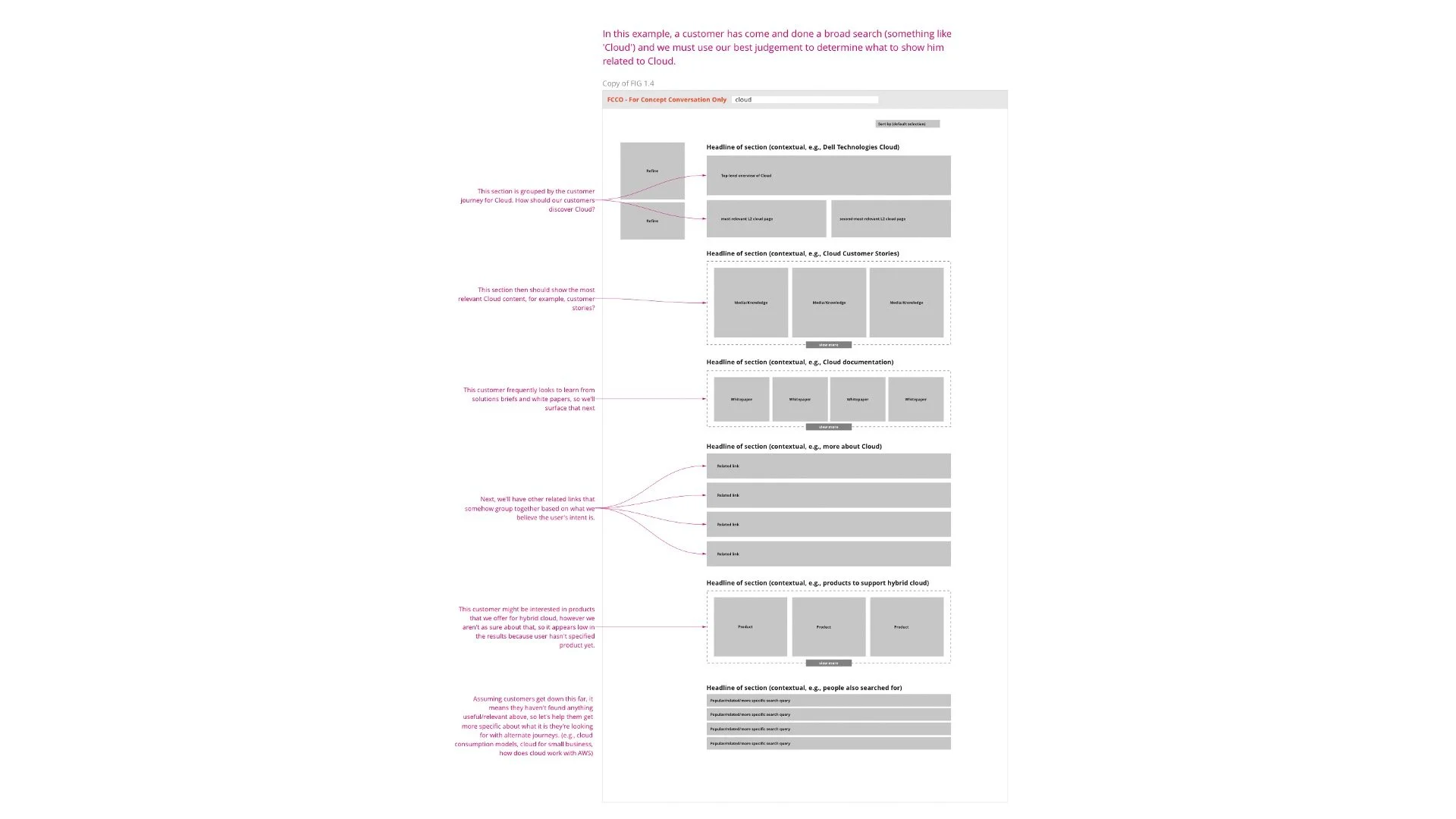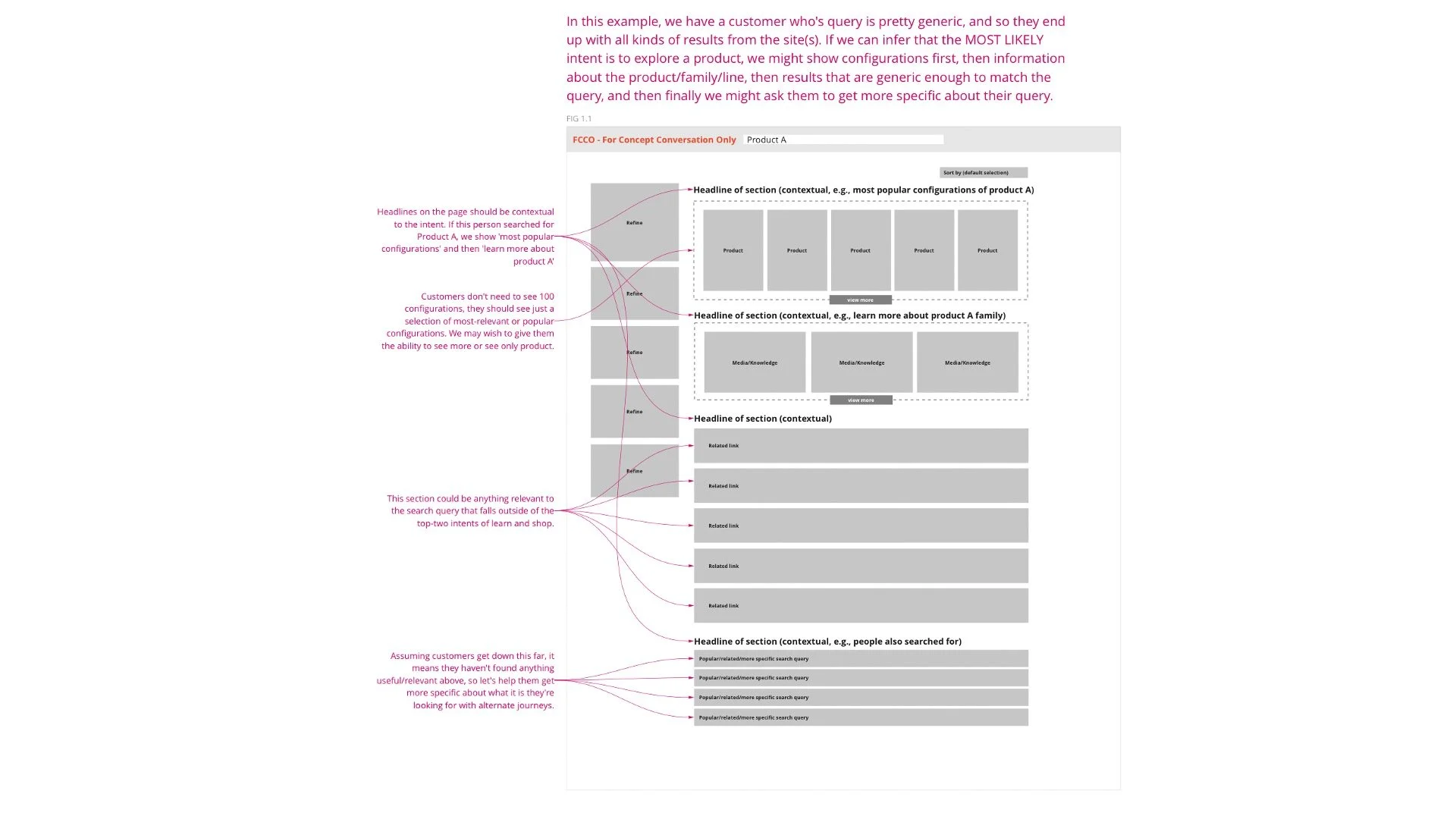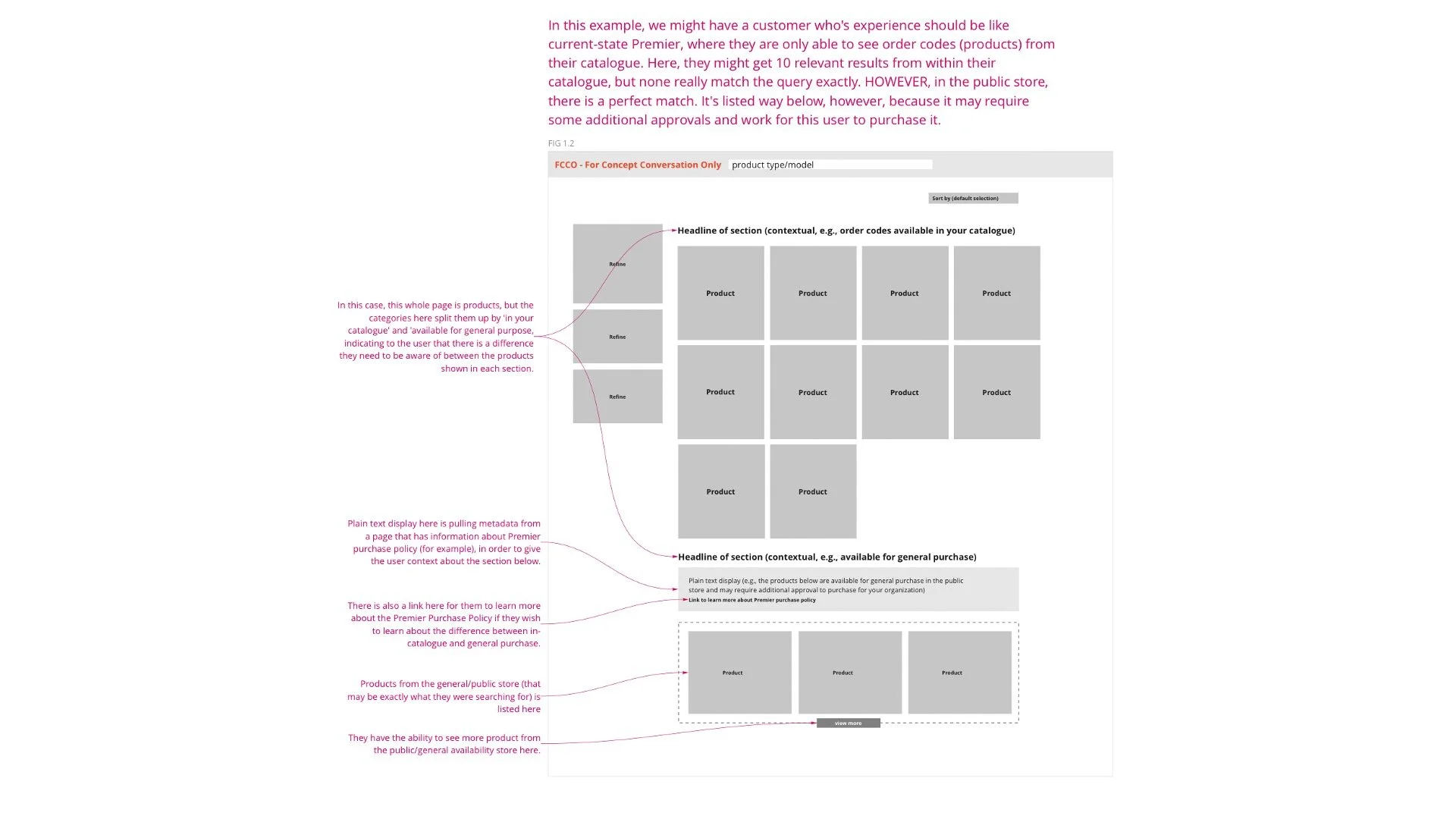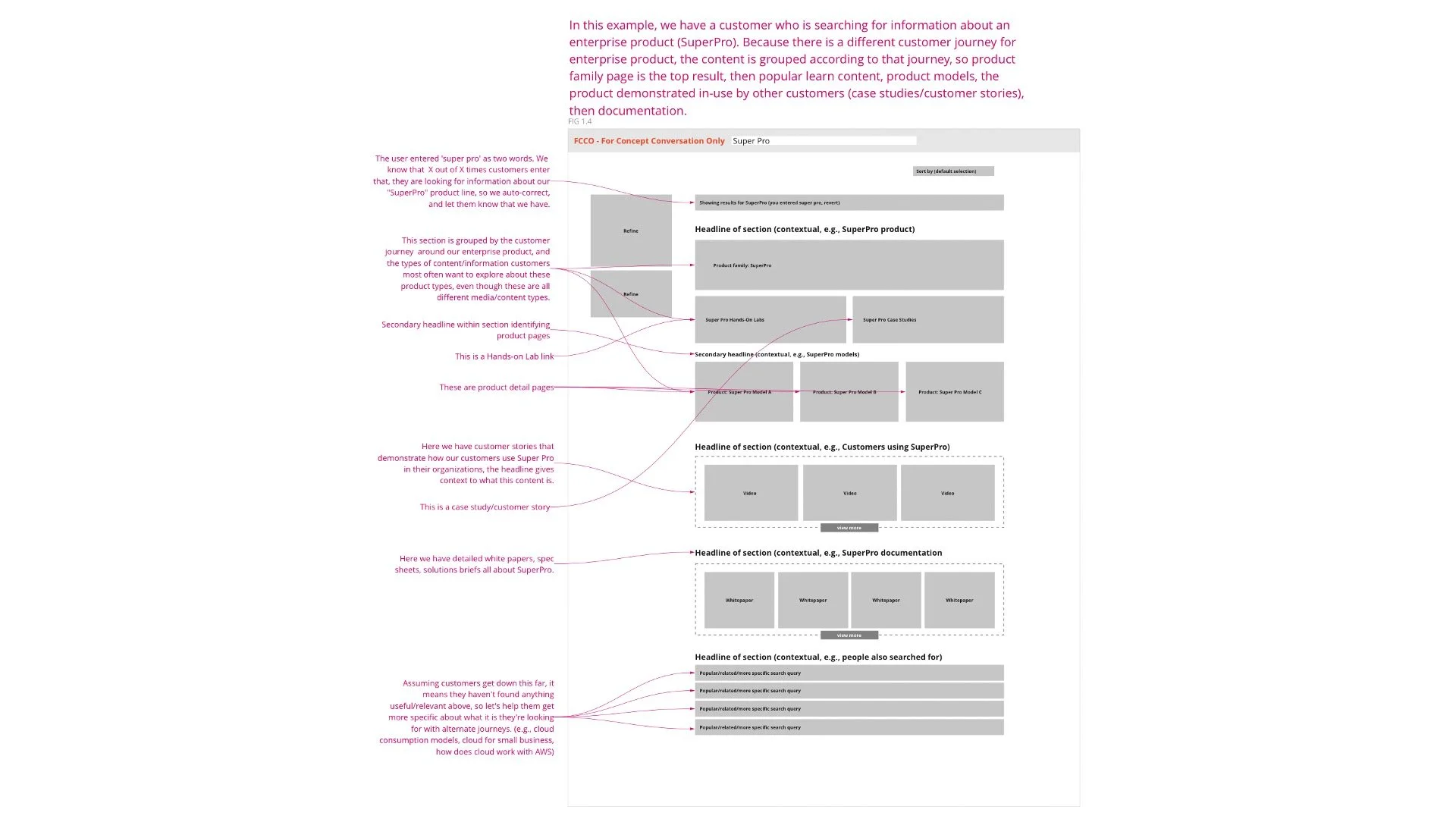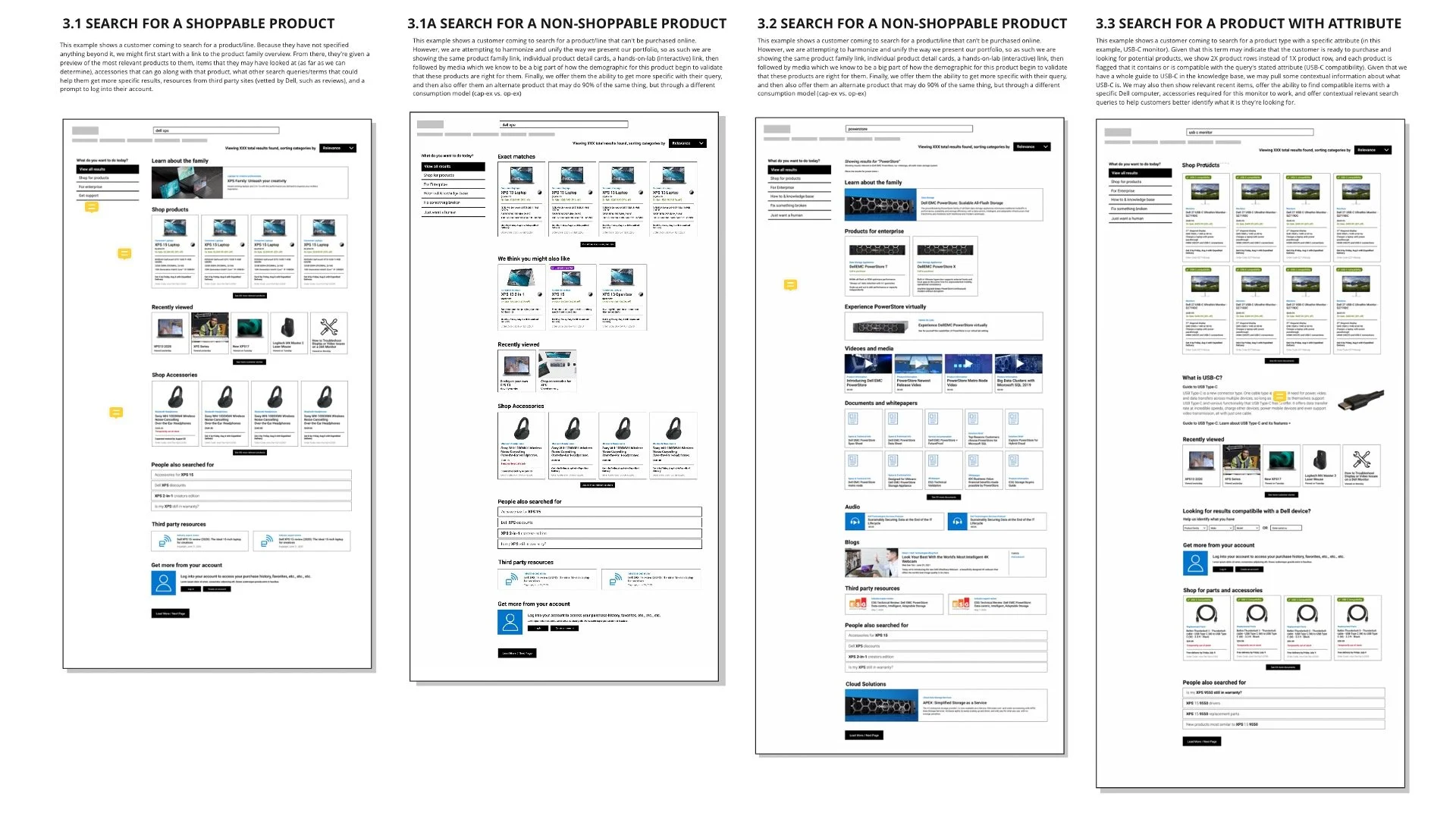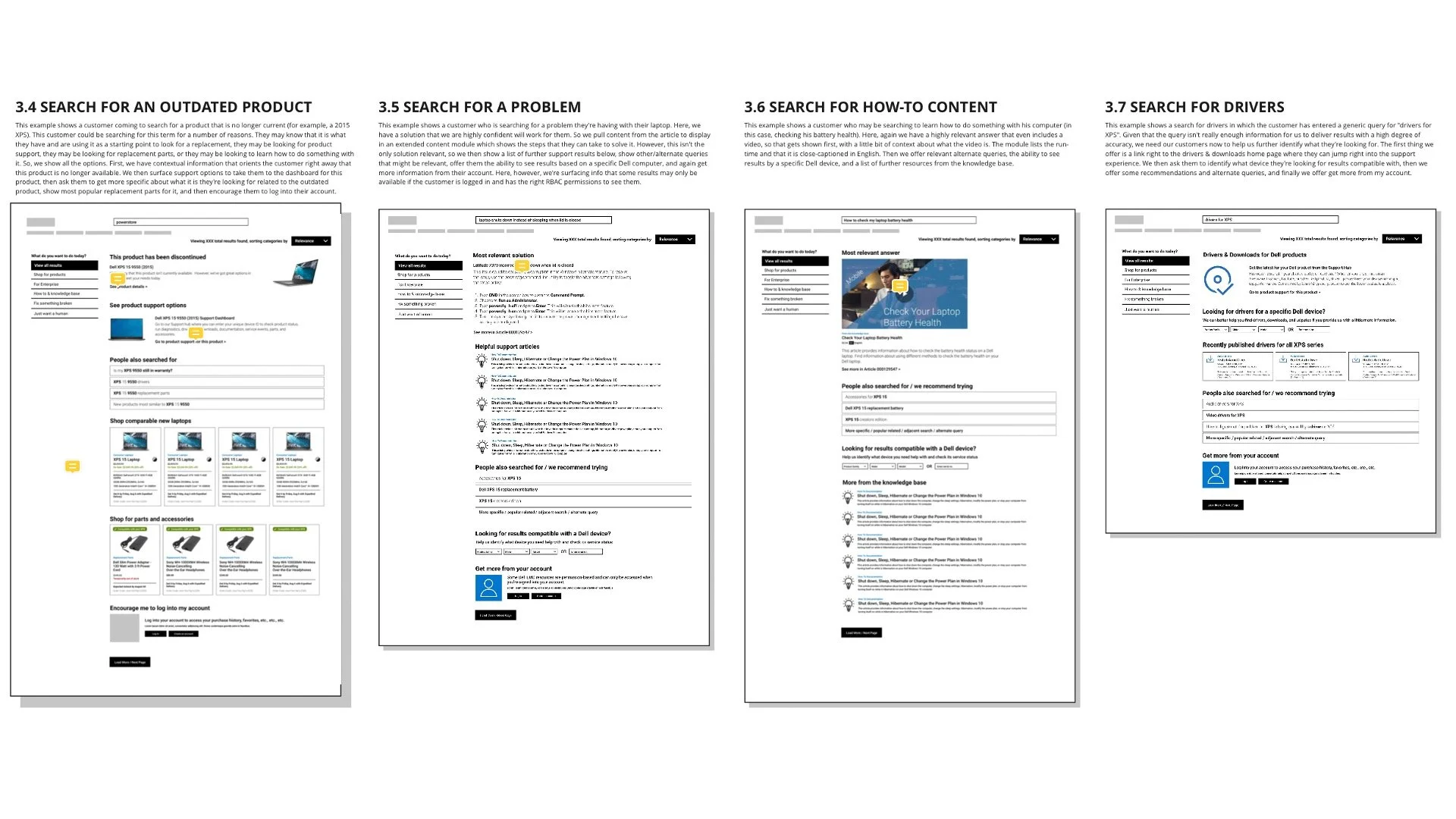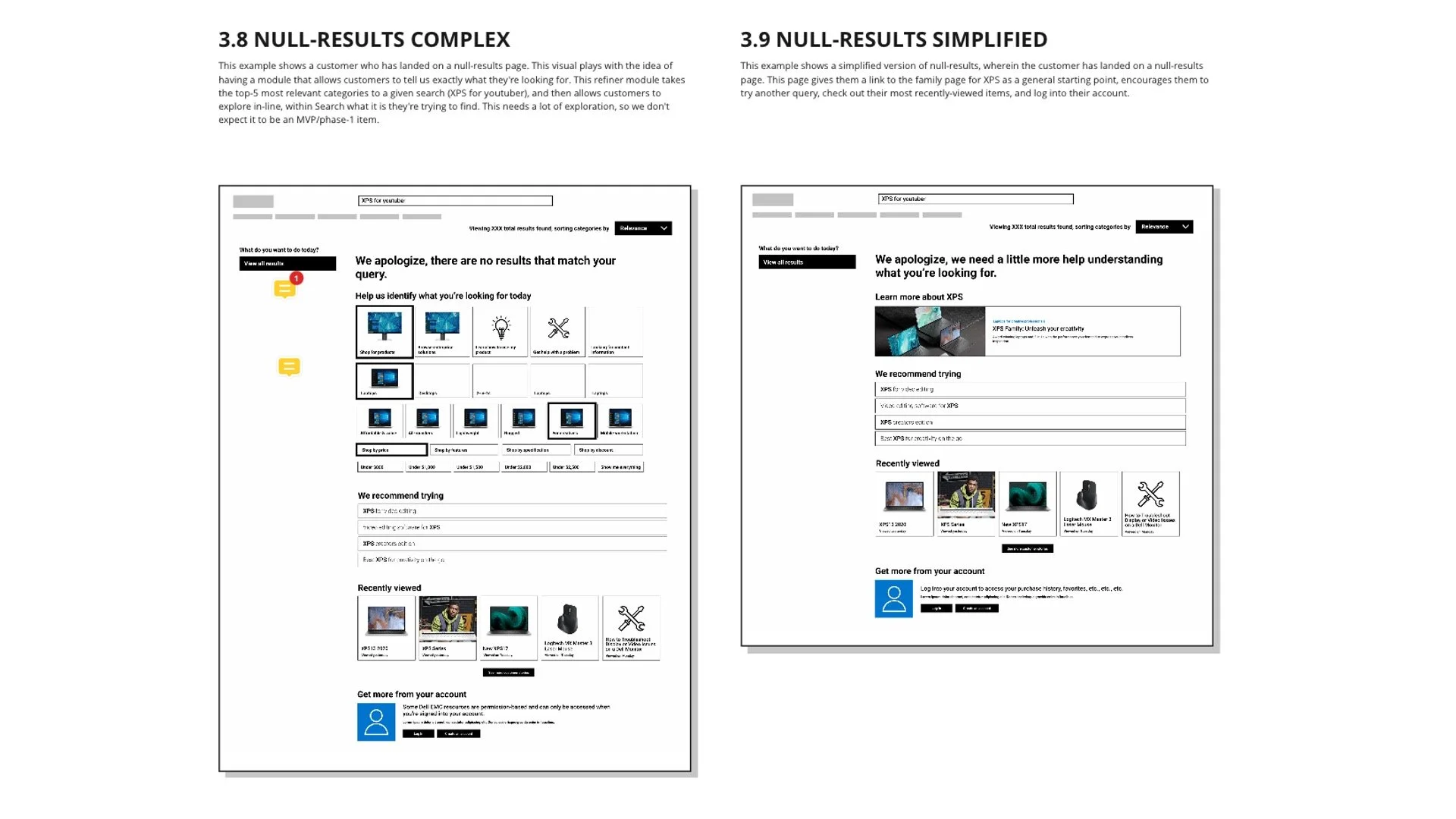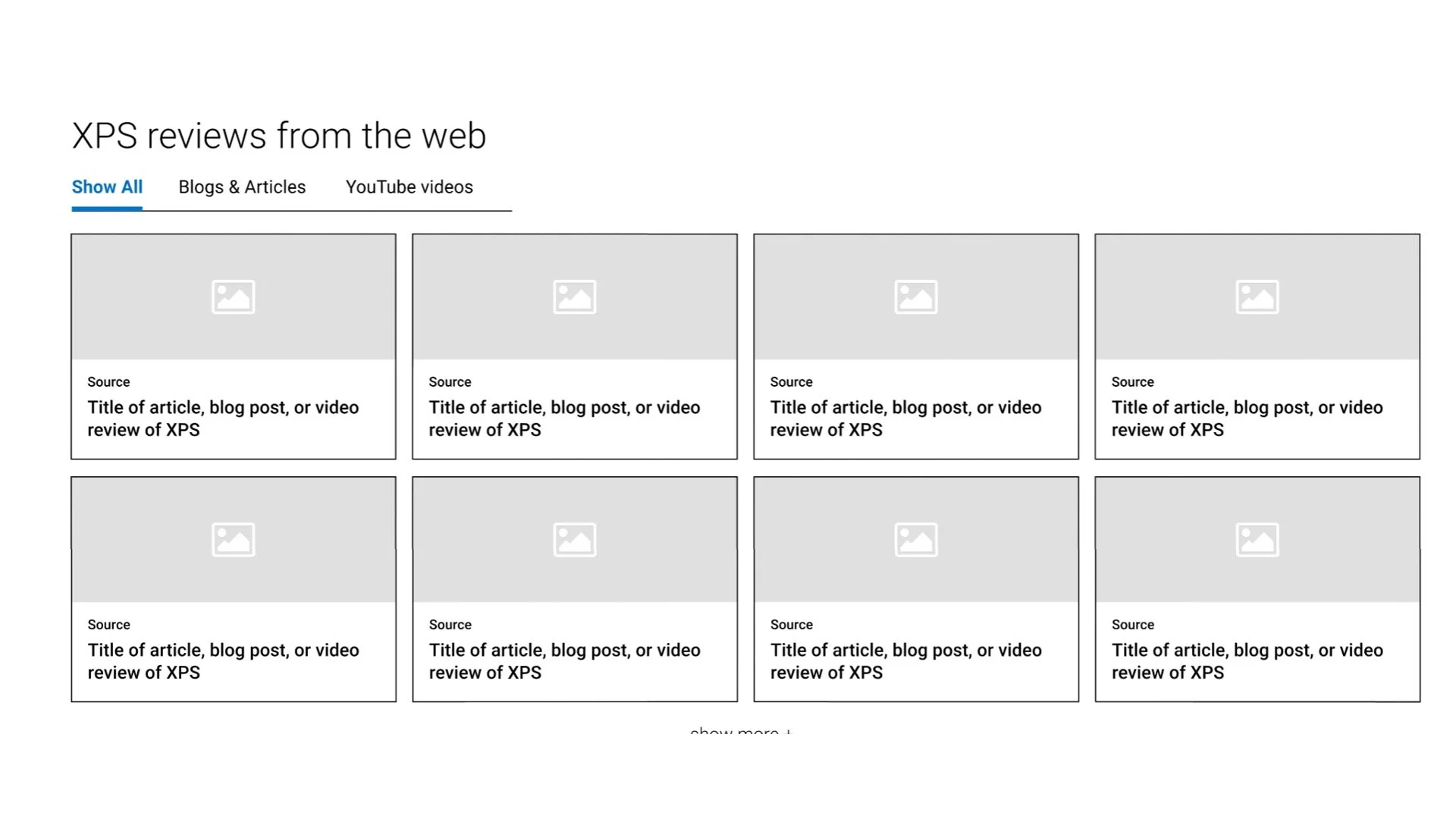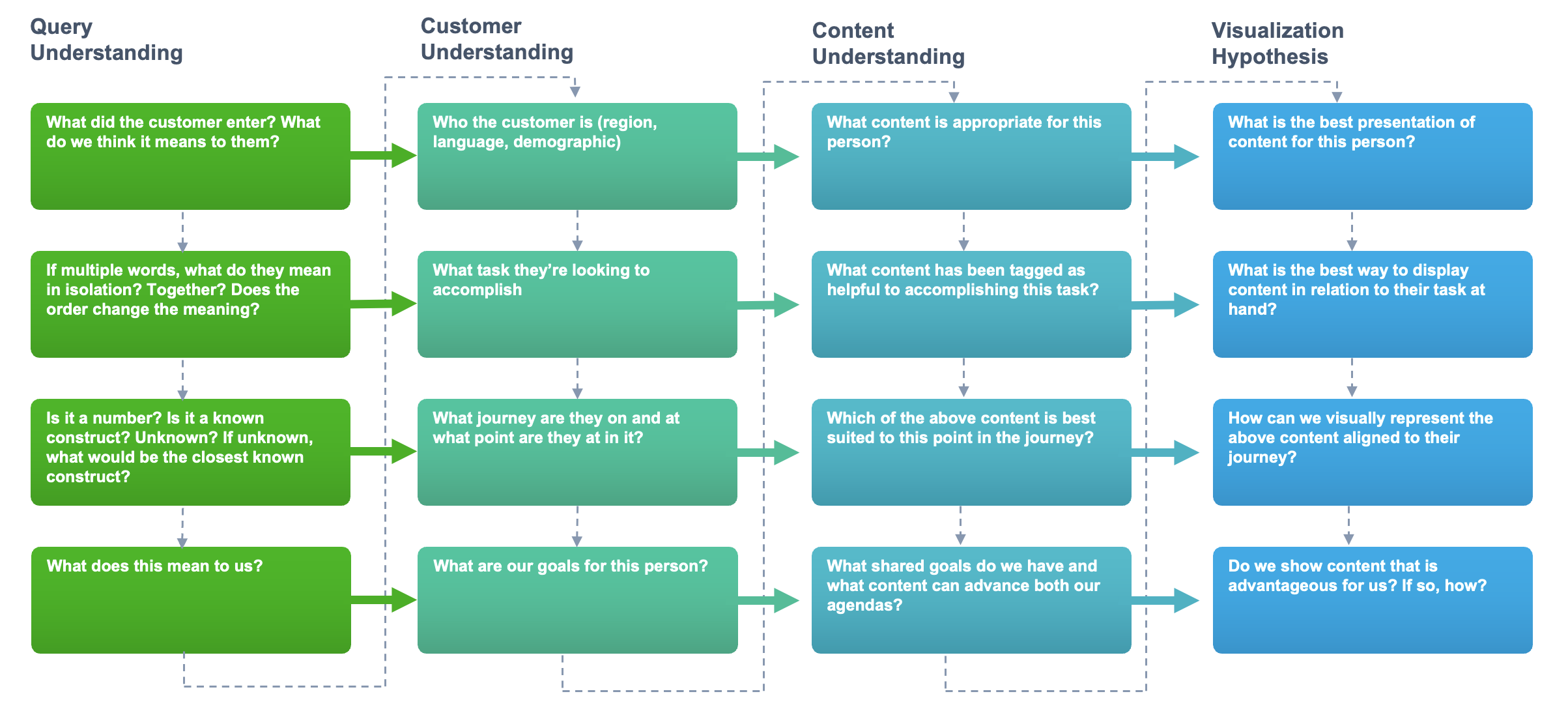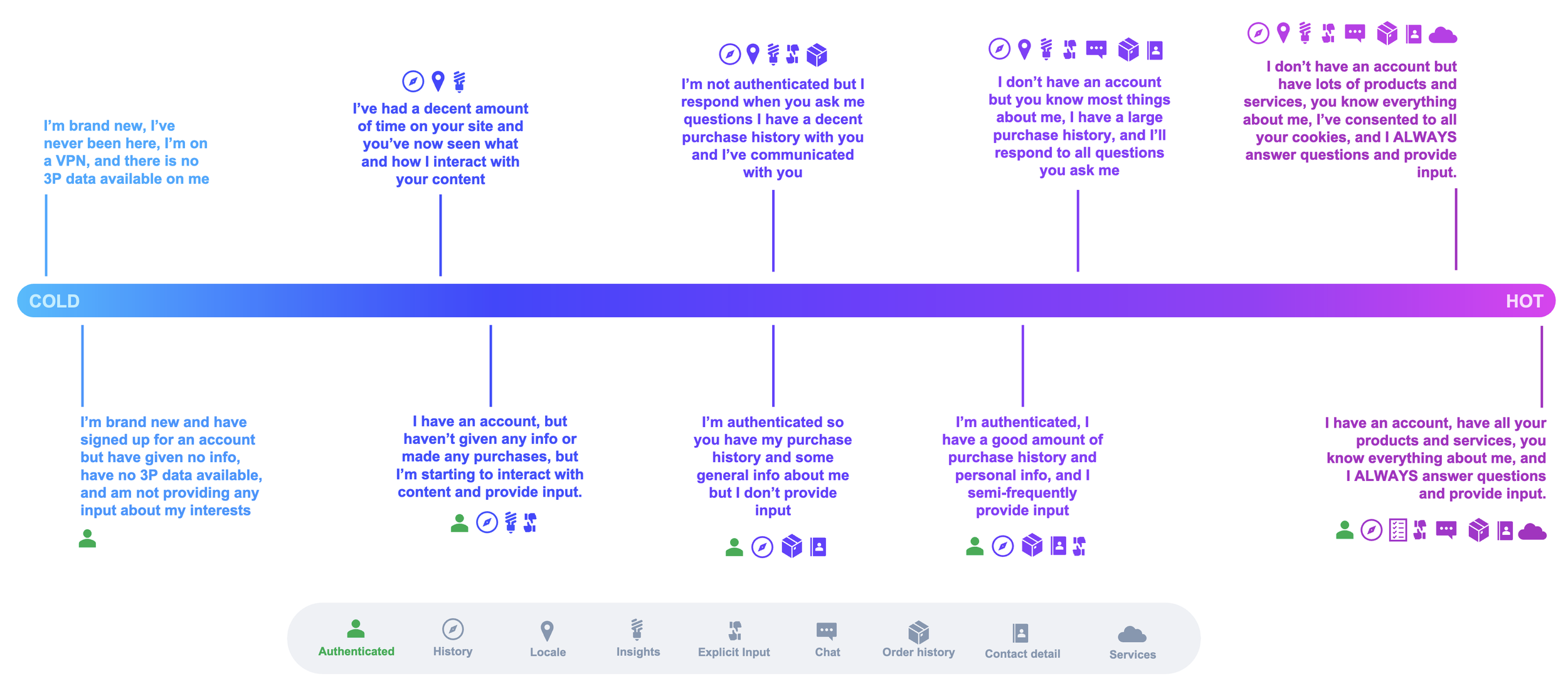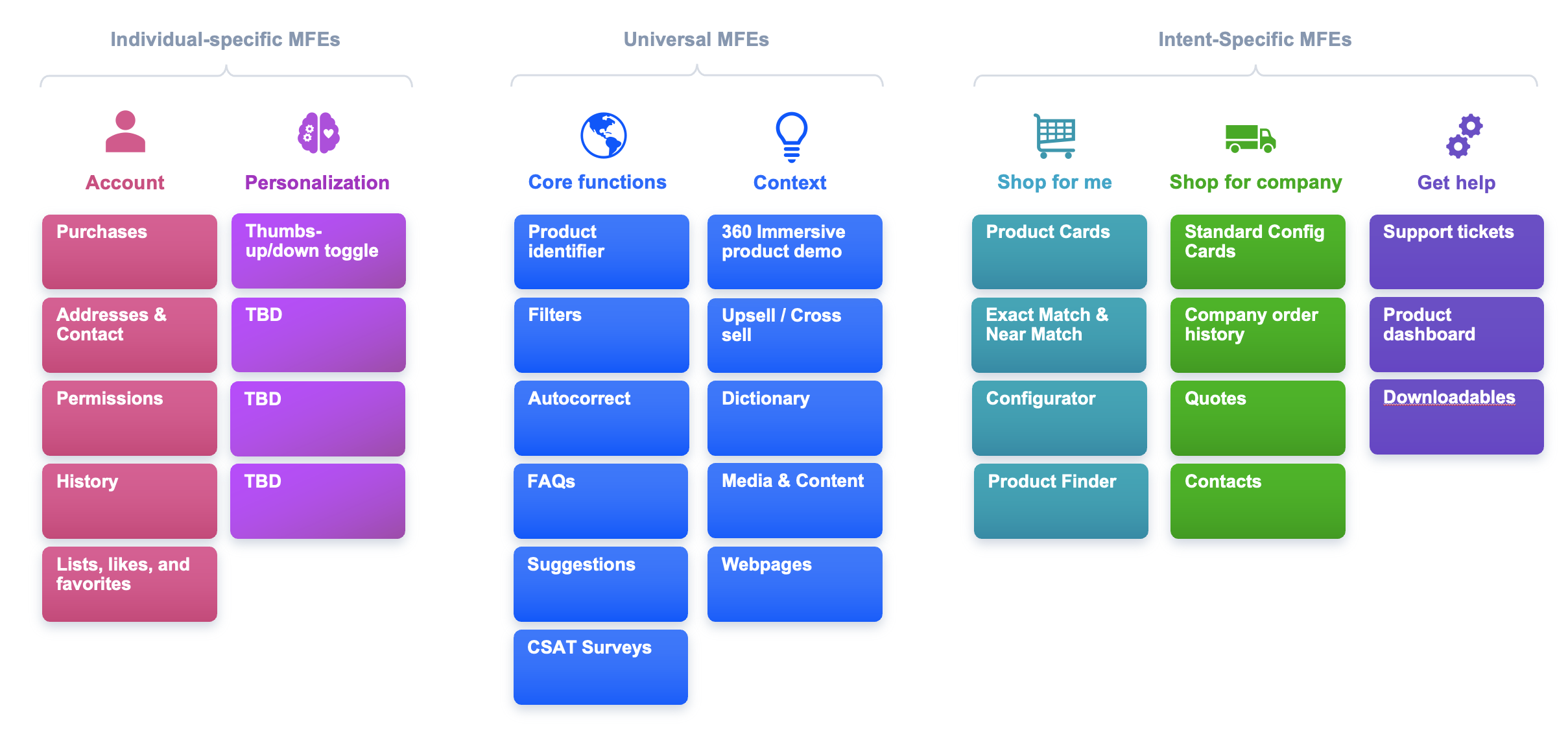Josh Lee James
Digital Product Strategist | Human Experience Evangelist
Dell Technologies public web unified search
With the directive to converge and unify four completely separate legacy websites into a single and unified Dell.com, it became imperative that the new site have an entirely new search experience that could flex and scale to support the vastly different customers who will visit it.
This meant rethinking search from the ground up in a way that few to no companies have ever done before. Let’s start by taking a look at the ecosystem that exists today and the four legacy domains that are being unified.
Each of the four domains were created by the different business units within Dell, built on different platforms (CMS, taxonomy managers, DAMs, etc.) and at present cater to a singular user base, most with very specific intents. This heavily informed everything about their architecture, structure, and end user experience.
Dell, Circle Dell, or better known as just Dell.com has historically encompassed the consumer and small business portfolio offering products such as its laptop and desktop lines and services such as consumer and small business finance. This is Dell’s B2C site.
Dell Premier offers the same products as Dell.com but is an entirely separate authenticated-only platform for businesses to establish company stores where IT departments and employees can procure Dell product at a lower, partner-only price.
Dell Technologies (formerly Dell EMC) caters to mid-market thru large-enterprise with industry-grade products such as workstations and converged infrastructure; solutions such as remote workforce, and services such as IT On Demand and APEX which is everything As A Service. This, in other words, is its B2B site.
Dell Support, also known as eServices, serves all the groups above and provides both informational and help/support/break-fix content about product, solution, or service one already owns.
If you haven’t yet looked at the Unified Customer Experience Vision & Strategy, it’s worth a look after you’re done here as it’ll show you the 4-6 year vision for what we imagine to be the end goal of building a unified digital experience: a truly next-gen, hybrid/meta/cross-platform unified experience.
However, until we get there, it was imperative that at the outset we design a unified search solution for the existing ecosystem; so that no matter which one of our customers you are (from the groups above), you’re still able to find and access all the content from across the now-much-larger ecosystem.
CHAPTER 1: DISCOVERY
We started with an extensive discovery & framing
This had to be one of the longest and most extensive discoveries most of us on the team had done (about 8 months). Because of the incredible complexity and our team’s desire to understand the landscape of search inside and out, it was important to us that we fully understand from both our internal search users as well as our external search users exactly what the landscape looked like for Search at present and what exactly we were there to improve.
Every customer segment included unmoderated surveys, studies, and moderated interviews. This section is showing the easiest to understand for an outsider, our consumer Search experience discovery, which included over 500 individual customer responses via unmoderated surveys and studies as well as 1:1 moderated interviews and focus group response (not easy in the virtual age, I must say).
At the end of each segment, we identified trends and narrowed down all of our data and insight into boards that identified each segment’s pain points/problem statements, opportunity statements, desires, wish lists, and our observation about how we could create and bring to life the ideal customer experience for our consumer customers.
Which generated an insights summary and POV
This was further distilled down into a deck like the one you can click through below, which highlights in short the ideal experience (along without out point of view on it), key opportunities for improvement within there (that we then began to translate into visualizations), how we wanted our executive team and Search organization to think about their overall experience, and areas for further exploration in the future.
Our Point of View was probably the most critical piece of each readout that we created as it summarized and outlined exactly how we understand Search at Dell and gave an informed opinion on the broad-strokes strategies that each group responsible for an area of the larger Search experience at Dell needed to keep in mind. For example, our consumer POV read as follows:
“In short, consumers are looking for an experience that speaks their language and is designed around their mental models.We have one of the broadest ranges of customers of any company, given Dell’s unique position in the marketplace. In the same way that we don’t design one single laptop and expect it to work for every single customer, we cannot design a one-size-fits-all search experience for every customer.
The driving force needs to be the customer’s mental model. What is their task? Why are the undertaking this task? What does completion mean for them? How are they planning on using our product? What do they care most about regarding the product? We need to anticipate customers needs be able to identify where they are in the purchase journey in order to serve them the right content and make sure we’re measuring success for each one of them the right way.
Further, we need to be able to serve up a visually rich experience written in simple language to those who need it and a technically-detailed experience to those who are more technically savvy.As we go forward and begin to realize this next-generation Search experience, flexibility and scalability must be prioritized in all executional strategies as it will be key in all aspects of our next-gen Search experience.”
CHAPTER 2: FRAMING
The beginning of the dynamic component-based system
What was evident right away through our discovery was that our search experience needed to be completely dynamic—meaning that every single thing about the experience needed to be able to change depending on who the individual human using it was. This couldn’t be your average e-commerce experience because traditional e-commerce accounts for less than 6% of Dell’s revenue and less than 25% of our overall web traffic. So we came up with the first iteration of our modular search platform (above) which shows how different queries (indicating intent or task) could serve up different content and experiences.
That led to our initial concept wireframes which took these initial scenarios and went into detail on what—and more importantly HOW AND WHY—each component module was placed on the page for each individual customer.
High-er fidelity wireframes for testing
After a few more rounds of exploration with our concept modular system, we began to detail a set of ten wireframes—different scenarios that we saw frequently in the actual search data on our site—that showed how a modular search platform designed around intent and task could fundamentally change how customers are able to use search on Dell’s website.
Finally, after we’d come up with the system that worked for us, we put it out to test with customers in both moderated and unmoderated studies once more.
Rapid iteration and validation
Customers LOVED our initial approach to a dynamic search experience like what they were having in each round. We
“I feel like this is great because it’s not
After a total of 4 rounds of this testing, we felt we had a solid system that worked and a s
CHAPTER 3: THE FINAL STRATEGY AND VISION
Fundamentally changing search by designing for task-oriented humans
We know that humans are task oriented. As one customer we spoke to put it:
“I don’t just go to websites for no reason… like I obviously have something to get done if I’m there, and I wish more sites would understand that at any given time I’m probably interested in only 1% of the content on your site.”
And that became the basis of how we think about intent. Before this, Dell has always had a very narrow and singular view of what “intent” is—with singular definitions of what is relevant to each intent. So the first thing we did was change that, by influencing the way the organization as a whole understands intent, what the object of that intent or task is, and then how to begin to cater to the customer.
Redefining how our engines intake and understand human input
The biggest challenge that combining all four sites into a single site created for us was that we had to architect an experience that would allow us to serve everyone from a consumer looking for a basic e-commerce search as well as an IT administrator looking for documents and resources and even a CIO looking to vet Dell Technologies as a worthy partner.
This meant that we really needed to build an engine or a system of engines that could identify using all available data points, what the query meant RELATIVE TO the person putting it into the box. For example…
Data storage can mean an entirely different thing to a consumer who may be looking for a $100 external hard drive as it does to an IT professional looking for a $200,000 NAS with Hyperconverged Infrastructure capabilities.
Even a simple term like XPS can and should trigger entirely different content and experiences depending on whether you’re a consumer looking for a single laptop for personal use or a business looking for 100 laptops and the relevant software to manage your new fleet.
The diagram above shows you a high-level view of the mental model that we established for our engines to run (and constantly re-run) in order to begin to generate content and the final end-user experience.
Customer understanding leads to personalization
Once we had enough intelligence and insight from the engines running the mental model in the previous section, we could then use all the same data points and insights to begin to personalize the experience. Now, personalization is a triggering word because it means so many different things to so many different people.
To some it means simply show me the products you think I’ll like most. But because our experience goes so far beyond e-commerce search, we took it ten steps further by thinking about what experience suits your task at hand the most—meaning, we don’t just personalize the results coming back, we look at all the data points we have available to us to curate your entire experience—results, content architecture, and UI (more on the second two below).
And, contrary to popular belief, authentication status isn’t the be-all, end-all that people think it is. It unlocks certain specific capabilities but we can still get hyper personalized to you no matter your authentication status. The more data points we’re able to access, the ‘warmer’ the experience can get for every customer.
Even in a zero-party data world.
A flexible and scalable content architecture and strategy
Once we’ve been able to identify the human, their intent and or task, and what content is most relevant to them at that given moment in time, it means we can begin to construct the actual end user experience.
However, content presented a challenge because again, our search experience needed to be able to transform and flex depending on the customer, their background, segment, intent/task, and the content most relevant to that intent and task. The same experience needed to be able to serve up (just to name a few):
A shop-oriented, e-commerce-type experience to consumers looking to buy a new device
A reference library-type experience to IT professionals and those looking for informational content
A solution debrief-type experience for IT professionals looking to learn about industry-grade solutions
A software and downloads library-type experience also for owners.
A product hub or dashboard-type experience to owners.
A community and forum-type experience for those looking to interact with other like-minded customers.
Which can be mixed and matched to create a different experience for every different customer
On top of that, we were very cognizant (from feedback we collected through over 1,500 customer surveys and interviews) that regardless of which of the above experiences (or combination thereof), no one wants to see irrelevant content.
Thus, we figured the best way to serve up the most relevant content to every user was through a flexible content architecture, in which we’d use tabs to segment the experience not by our own business verticals but by the way our customers think about the intent or task that they are there to accomplish.
For example: If I’m a consumer looking for a great gaming laptop, I don’t want to see enterprise/industry solutions or break/fix support. I want to see an overview of what you offer for gaming and why I should choose Alienware or G-Series (Dell’s gaming lines), all the products I can purchase, forums and communities dedicated to gaming.
Driven by Micro Front Ends
Once we’ve gone through the process of identifying the individual customer, their intent and task, and the right content and organization of said content; we now need to figure out how to present those relevant results WITHIN each tab through the front-end UI.
That’s where MFEs or Micro Front Ends come into play (see here if you’re unfamiliar with what MFEs are).
On a unified platform such as Dell is looking to develop, MFEs are perfect because they allow for cross-functional, technology-agnostic features to be built once to support all customer needs across the site and ecosystem.
So we said, by leveraging the MFEs that Dell was already building as well as adding some new ones and clearly delineating and defining the purpose of each (purpose for the end user), we’d be able to get all the right information in all the right tabs in the best format for consumption.
Driving MFEs by purpose
For unified site search, that means that the engine simply needs to identify which MFEs are relevant to the given intent, and following the content architecture and strategy, which tab each MFE needs to live within.
MFEs also support the flexibility and scalability that we needed out of our experience. Meaning, something like a product identifier MFE could be used for many if not all customer intents that have to do with using a product as a data point to refine a master data set down to a sub-set. Same with a product finder—as long as the MFE was designed and built to support all the use cases and mental models our customers have, we’d be able to plug it right into Search.
The Next-Gen Experience
Let’s look at how all this works in a basic, real-world use case. What you’ll see in the visuals below is how the experience for Nicki is entirely tailored to her very common use case of wanting a second monitor but not knowing much about monitors, what she really needs, and trying to make an informed decision on a purchase.
The general consumer looking for a monitor
So with her task of finding herself a new monitor, Nicki has come to Dell and is looking for a new monitor that will solve her needs for a work-from-home setup. She doesn’t know what she really needs other than that it has to be compatible with her MacBook. So we can infer that her time on our site should initially be spent learning and discovering what Dell has to offer her.
Nicki’s first tab: Help me find a monitor
Nicki is first presented with a tab that presents her with a series of MFEs that are designed to help her begin to find and learn about monitors in mental models that she understands. For example, she can enter the model number of her MacBook and only see compatible monitors. She can also use the product finder which has been presented in its use-case or quality-of-life view in order to let her self-identify what qualities she’s most interested in. And finally, she’s presented with some learning content to help her understand connection standards (USB-C, HDMI, etc.). Each and every MFE on this page also allows her to begin shopping right from it using her decision point as a refiner to generate an initial product set.
Nicki’s second tab: Shop Monitors
Once Nicki is ready to start shopping, whether she clicks on the next tab or enters the shopping experience via one of the MFEs, she’s presented with a typical shopping experience. The difference is that it’s now personalized at a deep level to her. In the left rail, we’re surfacing quality-of-life type refiners (which are the same MFEs we saw previously in-line on the page). In her results set on the right, we’ve also placed our Product Concierge which uses all the available data points we have on her and her needs to begin to formulate human-like product recommendations and provide individualized context about why each one is right for her and why we’ve recommended them.
The business (Dell Premier) shopper looking for laptops
In this example, we see one of our Premier customers coming to the new search experience to look for Dell Latitude laptops. In this instance, because of everything we know about this particular customer, we’ve shortcut them right into the shopping experience (versus the consumer who started on a learning-oriented page). However, even here, this is your typical e-commerce search but supercharged by personalization achieved by leveraging all the data we have about them.
For starters, we hope that our customers never even have to scroll. At the top of the page, we again see our product concierge MFE but tailored to our business customer and their mental models (so instead of good/better/best, we see your most to least purchased items) matching the refiners set and the query.
In addition to that, our Premier customers think in terms of projects (since this is their job, after all) and we imagine a future for Dell where their entire experience is oriented around projects such as those that Tonya has set up. And since that’s the primary way that TONYA THE HUMAN thinks about her work, it becomes her top filter. You’ll also see that products that have been tagged or added to projects also get a color-keyed indicator on the related product card.
Finally, because of the features that Premier accounts unlock and the way we know they work when it comes to roadmapping their fiscal years, products that will be reaching end of life in the next nine months are capped with a banner prominently alerting them that while such products may still be purchased (and even sometimes at a great discount), they will be discontinued soon.
By clicking on this banner, they’re presented with another shared MFE in the modal: our Product Lineage MFE. This shows the general family lineage of this product (so 5420 was replaced with 5520 and now will be replaced with 5620) and in addition, provides context and helpful links around each.
But not just context, context designed around their own human mental models.
The Response
This approach to the UI was hugely impactful to actual human users in our concept testing, who struggled with homogenous lists of text links, with many saying that being able to identify the kind of asset each link corresponds to was a huge timesaver and allowed them to zero in on exactly what content would best serve their task at hand, and quickly and efficiently move on to the next step in their journey through Dell’s online ecosystem.
The next phase of this journey is ramping up both our internal and external teams to begin engineering feasibility assessments as well as building Proofs of concept with various vendors who may be able to bring to life some of this immense functionality, and we can’t wait to share more with you in the coming months.
CLIENT: Dell Technologies
ROLE: Lead Product Designer and Strategist
YEAR: 2021 to present (ongoing)




